How to Start a Pet Sitting Business From Scratch

Want to know how to start a pet sitting business? Good, you’re in the right place!
There are a bunch of ways to get started as a pet sitter:
- You could keep it small and just look after the pets of your friends and family.
- You could cast the net a little wider and register on a pet sitting platform like Rover.
- You could even take your pet sitting business international with apps like TrustedHousesitters.
In this post I’m going to take you through another option: Setting up your own pet sitting business from scratch.
There are pros and cons to this; there’s a lot more work up front to get started and your growth might be slow going at first, but you’ll have full control over how you market yourself, what you charge and how you choose to operate.
I’ll walk you through how to plan your business, take care of the legal stuff, set up your operations, pricing and marketing. I’ll also give you tips on providing the best care for your clients and how to grow your business.
Want to know more about the ins and outs of pet sitting in general? Check out this ultimate guide!
Planning Your Pet-Sitting Business
While you’ll likely be excited to get started setting up your pet sitting business, it can still be a bit overwhelming. Like any business, getting the foundations right in your planning will give you a much better chance of success.
Here’s what to do:

Define Your Services
The first step in planning your pet-sitting business is to decide exactly what services you’ll offer. This decision will shape everything from your marketing strategy to your pricing structure.
Common pet-sitting services
- Daily dog walks
- In-home pet visits
- Overnight pet sitting
- House sitting with pet care
- Pet taxi services
Think about your skills, experience, resources and available time. If you’re great with dogs but uncomfortable with exotic pets, focus on canine services. If you don’t want your lovely two-seater Porsche to get covered in dog hair, maybe avoid pet taxi services.
Identify Your Target Market
Once you’ve decided on your services, it’s time to think about who your ideal clients are. This step will help you tailor your offerings and marketing efforts.
Potential target markets
- Busy professionals who work long hours
- Families who travel frequently
- Elderly pet owners who need help with daily pet care
- New pet owners who need extra support
Research your local area to understand the demographics and pet ownership trends. Are there lots of young professionals with dogs? Maybe you live in an area full of jet-setting cat ladies? This information will help you focus your efforts where they will most likely pay off.
Research Local Competition
Before you can stand out in the market, you need to know what you’re up against. Have a look at what other pet sitters are offering in your area.
Local competition
- What services do they offer?
- How much do they charge?
- What makes them unique?
- Are there any gaps in the market you could fill?
This research will help you identify opportunities to differentiate your business and set competitive prices.
Create a Business Plan
With your research complete, it’s time to put it all together in a business plan. This document will be your roadmap as you launch and grow your pet sitting business.
What to include in your business plan
- An executive summary outlining your business idea
- A description of your services
- Market analysis detailing your target clients and competition
- Marketing and sales strategies
- Financial projections, including startup costs and expected revenue
Your business plan should fit the size and scale of your business. If you’re setting up as a pet sitter full-time, you’ll want a little more detail than if you’re running your business as a side hustle.
You could just skip all this and wing it – you might be ok! But even a basic business plan will give you peace of mind that you know what you’re doing and will help you figure out what to do if you get stuck.
Legal Requirements and Insurance
When starting your pet sitting business, you need to make sure you’re operating legally and have the proper protections in place. This not only keeps you on the right side of the law but also gives your clients peace of mind.

Register Your Business with HMRC
One of the first steps in setting up your pet sitting business is to register with HM Revenue and Customs (HMRC). This is a legal requirement for all businesses in the UK.
Here’s what you need to do
- If you’re operating as a sole trader, register for Self Assessment
- If you’re setting up a limited company, register with Companies House
- Register for VAT if your annual turnover is expected to exceed £85,000 (if you manage this as a pet sitter, please let me know how you did it!)
Once registered, you’ll need to file annual tax returns and pay any taxes due. Setting aside money for taxes throughout the year is a good idea to avoid any nasty surprises.
You don’t need to do this if you’re setting up as a side gig and earn less than £1000 per year.
Obtain Necessary Licences and Permits
Depending on where you live in the UK, you may need specific licences or permits to operate a pet sitting business.
Check with your local council about:
- Home boarding licences (if you’ll be keeping pets overnight in your home)
- Animal boarding establishment licences (if you’ll be boarding animals in a separate facility)
- Dog walking licences (some councils require these for professional dog walkers)
It’s better to be safe than sorry, so don’t skip this step. Where I live, I have to register as a professional dog walker – it takes about 30 seconds to fill out the form and it doesn’t cost anything.
Operating without the proper licences could lead to fines or even force you to shut down your business.
Pet Sitting Insurance
You need insurance to protect your business, yourself, and the pets in your care. There are several types of insurance you should consider:
Types of Insurance
- Public liability insurance: Covers you if a pet in your care injures someone or damages property
- Care, custody, and control insurance: Protects you if a pet is injured or falls ill while in your care
- Key cover: Covers the cost of replacing clients’ keys if you lose them
Some insurance providers offer comprehensive pet business insurance packages that include all these types of coverage.
Professional Organisations
It’s not a legal requirement, but joining a professional pet sitting organisation can lend credibility to your business and provide valuable resources.
Why Join a Professional Organisation?
- Access to training and certification programs
- Networking opportunities with other pet care professionals
- Resources for running your business, like contract templates
- Listing in the organisation’s directory which can help clients find you
Some reputable organisations in the UK include the National Association of Pet Sitters and Dog Walkers (NarpsUK) and the Association of Professional Dog Walkers (APDW).
Setting Up Your Operations
Once you’ve sorted out the legal bits, it’s time to get your pet sitting business up and running.
A good operations system will help you provide top-notch service to your furry clients and their owners.
Here’s what to focus on:
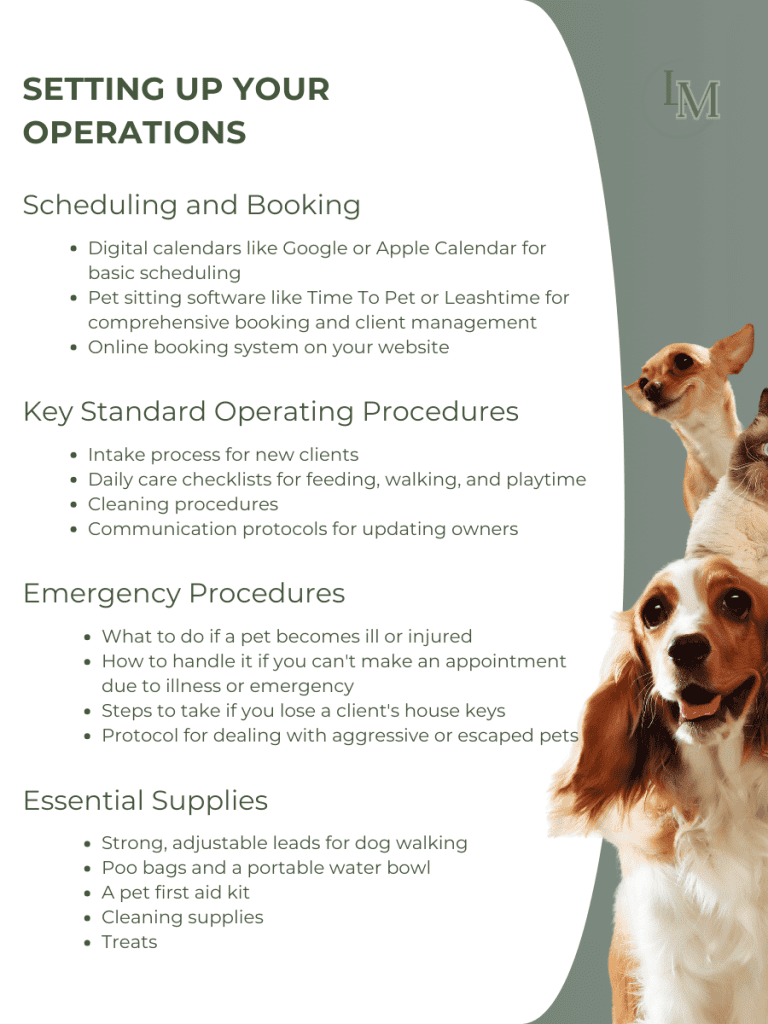
Schedule and Booking System
It doesn’t matter how you do it, but you need a schedule and booking system. You need to keep track of your appointments, avoid double-bookings, and make sure you’re not overextending yourself.
Booking Systems
- Use a digital calendar like Google Calendar or Apple Calendar for basic scheduling.
- Invest in pet sitting software like Time To Pet or Leashtime for more comprehensive booking and client management.
- Set up an online booking system on your website to make it easy for clients to schedule services.
Remember to integrate the rest of your schedule with your system. The last thing you want is to have to cancel a booking because you forgot about that weekend away you have booked in on your other calendar.
Pet Care Protocols and Emergency Procedures
Every pet sitting job is unique, but having standard operating procedures (SOPs) in place will ensure you’re always prepared.
Key Standard Operating Procedures
- Intake process for new clients, including gathering detailed information about the pet’s needs and routines
- Daily care checklists for feeding, walking, and playtime
- Cleaning procedures for litter boxes, cages, or other pet areas
- Communication protocols for updating owners about their pets
Emergency Procedures
Your emergency procedures should cover:
- What to do if a pet becomes ill or injured
- How to handle it if you can’t make an appointment due to illness or emergency
- Steps to take if you lose a client’s house keys
- Protocol for dealing with aggressive or escaped pets
These procedures will give you and your clients peace of mind. You can help reduce the risk of injury to pets by pet-proofing your home.
Supplies and Equipment
Having the right tools to hand makes running your pet sitting business easier. While you don’t need to break the bank, investing in quality equipment is worth it in the long run.
Essential Supplies
These might include:
- Strong, adjustable leads for dog walking
- Poo bags and a portable water bowl
- A pet first aid kit
- Cleaning supplies for dealing with accidents
- Treats (with owner’s permission) for rewarding good behaviour
You can adjust this list to suit your own needs depending on the types of services you offer.
Pricing Your Services
It’s important to get your pricing right. Price too high, and you might struggle to find clients. Price too low, and you could end up working yourself to the bone without making a decent profit.
Here’s how to approach pricing in a way that’s fair to both you and your clients.
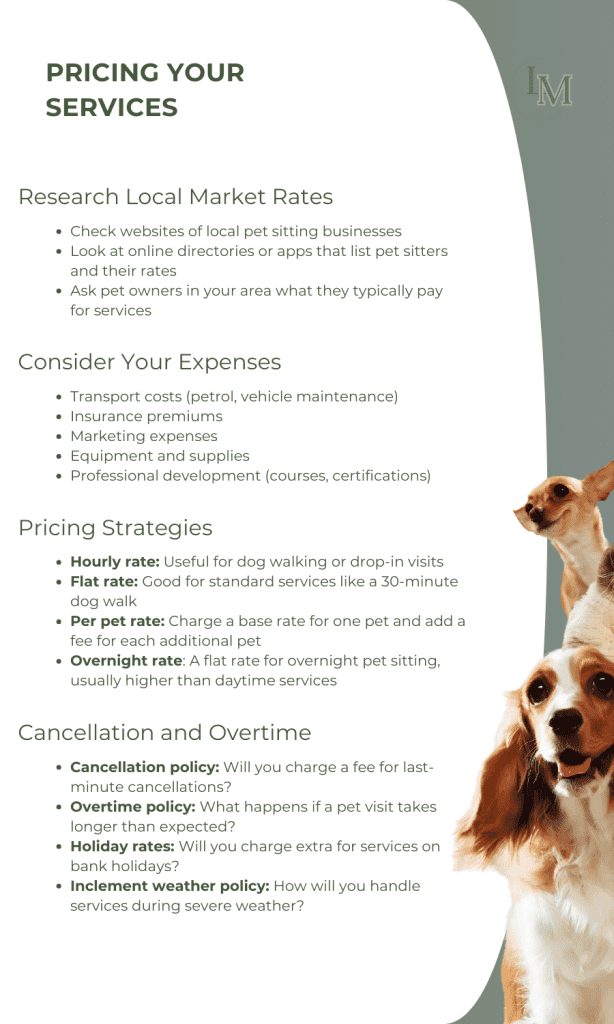
Research Local Market Rates
Before you set your prices, you need to know what other pet sitters in your area are charging.
How to Research Local Market Rates
- Check websites of local pet sitting businesses
- Look at online directories or apps that list pet sitters and their rates
- Ask pet owners in your area what they typically pay for services
Remember, your goal isn’t necessarily to be the cheapest option. Instead, you want to price your services competitively while reflecting the quality of care you provide.
Calculate Your Costs and Desired Profit Margin
To run a sustainable business, you need to cover your costs and make a profit. Start by listing all your expenses.
Everyday Expenses for Pet Sitters
- Transport costs (petrol, vehicle maintenance)
- Insurance premiums
- Marketing expenses
- Equipment and supplies
- Professional development (courses, certifications)
Create a Pricing Structure
With your research and costs calculated, it’s time to set your prices. Most pet sitters use a combination of pricing strategies.
Pricing Strategies
- Hourly rate: Useful for dog walking or drop-in visits
- Flat rate: Good for standard services like a 30-minute dog walk
- Per pet rate: Charge a base rate for one pet and add a fee for each additional pet
- Overnight rate: A flat rate for overnight pet sitting, usually higher than daytime services
Some pet sitters offer package deals for regular clients. For example, a discount for booking five walks per week or a reduced rate for extended holiday stays.
Cancellation and Overtime Policies
Clear policies help set expectations and prevent misunderstandings with clients.
Key Policies You Should Consider
- Cancellation policy: Will you charge a fee for last-minute cancellations?
- Overtime policy: What happens if a pet visit takes longer than expected?
- Holiday rates: Will you charge extra for services on bank holidays?
- Inclement weather policy: How will you handle services during severe weather?
It doesn’t happen often, but it’s less awkward for everyone if your clients know in advance what will happen if they turn up late from work to pick up their pet or if they’re on holiday and their flight gets delayed.
Be sure to communicate these policies clearly to clients before they book your services. Including them in your contract can help avoid disputes down the line.
Marketing Your Pet Sitting Business
You need a way to get the word out about your business to attract clients. With the right marketing strategies, you can showcase your services and build trust with pet owners.
Here’s how to market your pet sitting business.
Looking for ways to market your business for free? Check out this post with 7 strategies to market your pet sitting business at no cost!
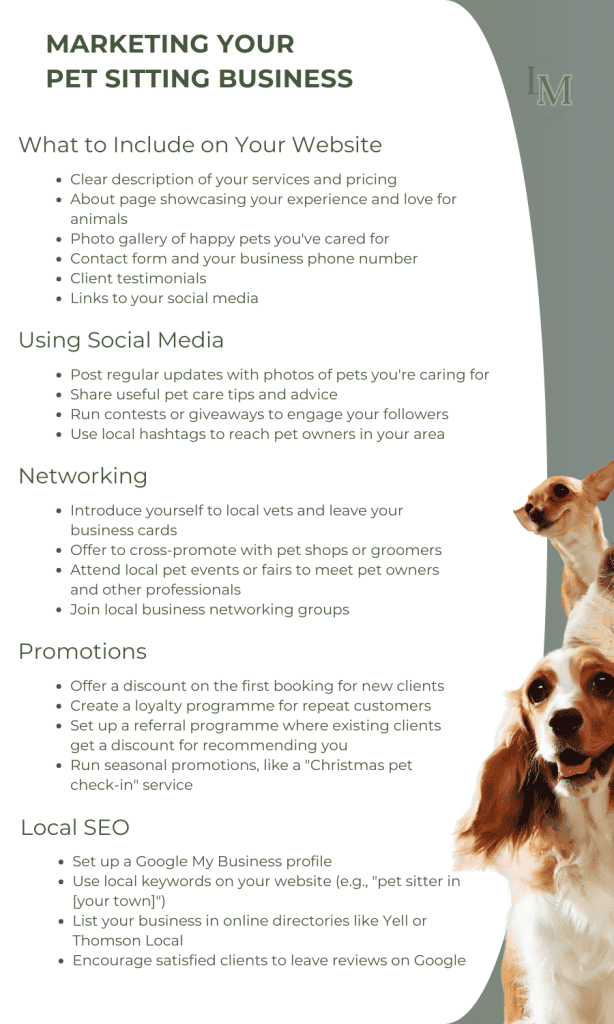
Build a User-Friendly Website
A website is often the first point of contact between you and potential clients. Your website should be easy to navigate and provide all the essential information about your services.
What to Include on Your Website
- Clear description of your services and pricing
- About page showcasing your experience and love for animals
- Photo gallery of happy pets you’ve cared for (with owners’ permission)
- Contact form and your business phone number
- Client testimonials to build trust
- Links to your social media
You can start simple with a website if you want. You’re good to go as long as a client can find out who you are, what you offer and how to contact you. You can add all the other stuff in as you grow.
Social Media Platforms
Social media is a powerful tool for connecting with pet owners and showcasing your services. It’s also a great way to share your personality and build relationships with potential clients. You don’t have to go overboard and spend all your time maintaining multiple social media accounts – a facebook or Instagram page will be enough.
Using Social Media
Here are some ways you could use social media to market your business:
- Post regular updates with photos of pets you’re caring for (again, with permission)
- Share useful pet care tips and advice
- Run contests or giveaways to engage your followers
- Use local hashtags to reach pet owners in your area
You don’t necessarily have to have a social media platform to run a successful dog sitting business, but it can help you stand out if you’re in a competitive location.
Network with Local Vets and Pet Shops
Building relationships with other pet professionals is a good way to get referrals.
Networking:
- Introduce yourself to local vets and leave your business cards.
- Offer to cross-promote with pet shops or groomers.
- Attend local pet events or fairs to meet pet owners and other professionals.
- Join local business networking groups.
Be genuine in your networking efforts. Focus on building relationships rather than just promoting your services.
Offer Introductory Discounts or Referral Programmes
Everyone loves a good deal, and offering discounts can encourage new clients to try your services.
Promotions
- Offer a discount on the first booking for new clients
- Create a loyalty programme for repeat customers
- Set up a referral programme where existing clients get a discount for recommending you
- Run seasonal promotions, like a “Christmas pet check-in” service
When offering discounts, ensure you’re still covering your costs and not undervalue your services.
Local SEO and Online Directories
Make sure pet owners can find you when they search online for pet sitters in your area.
Local SEO
- Set up a Google My Business profile
- Use local keywords on your website (e.g., “pet sitter in [your town]”)
- List your business in online directories like Yell or Thomson Local
- Encourage satisfied clients to leave reviews on Google
Building a strong online presence takes time but is worth the effort.
Providing Top-Notch Pet Care
At the heart of every successful pet sitting business is the quality of care provided to the animals. Your ability to offer exceptional pet care will not only keep your furry clients happy but will also lead to satisfied pet owners who are likely to become repeat customers and recommend your services to others.
Here’s how to ensure you’re providing the best possible care.
Develop a Meet-and-Greet Process for New Clients
First impressions count, both with the pets and their owners. A well-structured meet-and-greet session sets the tone for your professional relationship.

How to Set Up a Successful Meet and Greet
- Schedule the meeting at the client’s home or on a regular walking route where the pet feels comfortable
- Ask detailed questions about the pet’s routine, diet, and any health issues
- Observe how the pet responds to you and interact with them if they’re willing
- Discuss your services, policies, and pricing in detail
- Take notes to refer back to during your pet sitting sessions
A meet and greet is as much about the pet getting to know you as it is about you learning about the pet. Take your time and don’t rush the process.
For a more in depth look at meet and greets, check out this dedicated post!
Create Detailed Pet Care Plans
Every pet is unique, and having a tailored care plan for each animal ensures you meet their needs.
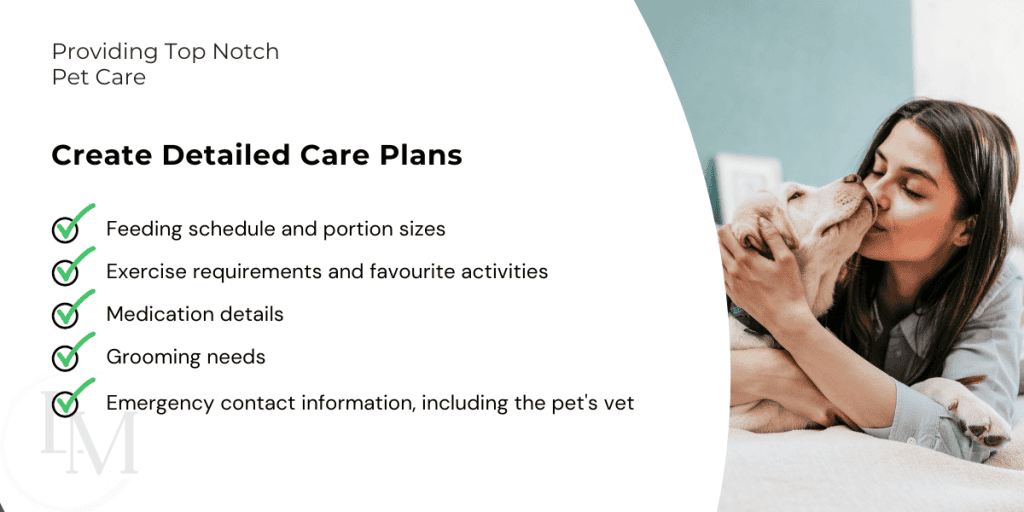
What to Include in a Care Plan
- Feeding schedule and portion sizes
- Exercise requirements and favourite activities
- Medication details if applicable
- Grooming needs
- Emergency contact information, including the pet’s vet
Implement a Communication System for Pet Updates
Regular updates can provide peace of mind to pet owners, especially when they’re away for extended periods.

Communication Strategies
- Send a quick text or photo after each visit
- Use a pet sitting app that allows real-time updates and GPS tracking of walks
- Offer end-of-day summary emails for overnight stays
- Be honest about any issues that arise, but balance this with positivity about the pet’s overall wellbeing
You should agree upon the level of communication with the owner beforehand. Some may want frequent updates, while others prefer to hear from you only if there’s an issue.
Keep Up To Date on Pet Care Best Practices
Staying informed about the latest pet care trends and research will help you to provide top-notch care.
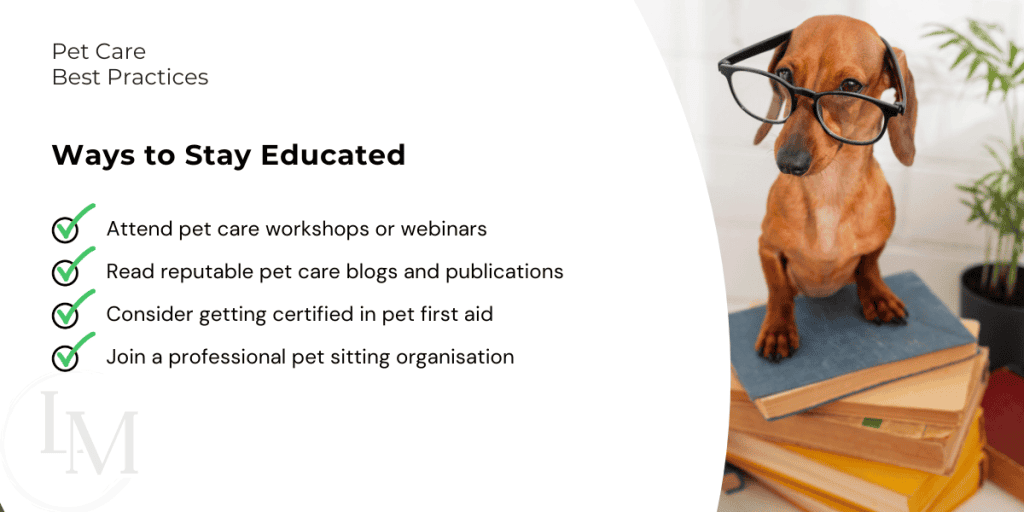
Ways to Stay Educated
- Attend pet care workshops or webinars
- Read reputable pet care blogs and publications
- Consider getting certified in pet first aid
- Join professional pet sitting organisations for access to resources and training
Don’t be afraid to share your knowledge with clients. They’ll appreciate your commitment to providing the best care for their pets.
Handle Challenging Situations with Care
Even with the best preparation, you may encounter difficult situations. How you handle these can make or break your reputation.

Tips for Managing Challenges
- Stay calm and composed, even if a pet is misbehaving
- Have a plan for common issues like a pet refusing to eat or take medication
- Know when to contact the owner or seek veterinary help
- Be honest with owners about any problems, but also offer solutions
Being able to handle tricky situations professionally can turn a potential negative into a positive in the eyes of your clients.
Growing Your Business
Once you’ve established your pet sitting business and built a solid client base, you might start thinking about expansion. Growing your business can lead to increased profits and a more stable income, but it also comes with new challenges.
Here’s how to take your pet sitting business to the next level.
Add Complementary Services
Diversifying your service offerings can attract new clients and increase revenue from existing ones. Think about what additional services might be valuable to pet owners in your area.
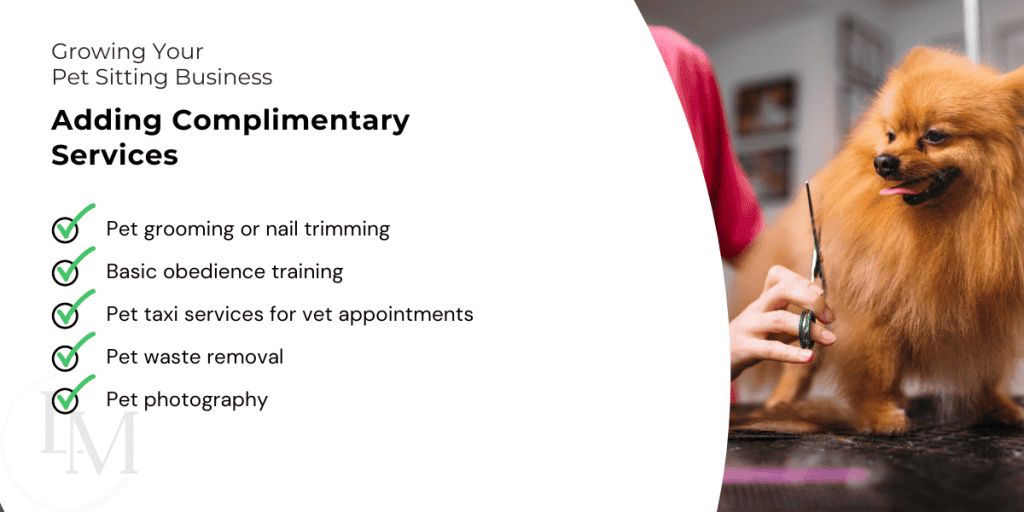
Complementary Services
- Pet grooming or nail trimming
- Basic obedience training
- Pet taxi services for vet appointments
- Pet waste removal
- Pet photography
- Dog Walking
You might need to pick up some extra skills or get the proper certification before offering these services, but if you’re committed to growing your pet sitting business, the investment will be worth it.
Client Testimonials and Reviews
As your business grows, building and maintaining a strong reputation becomes even more important. Positive reviews and testimonials will help you attract new clients more than anything else you do.

Gathering Testimonials
- Ask satisfied clients if they’d be willing to provide a testimonial
- Make it easy for clients to leave reviews on platforms like Google My Business or Trustpilot
- Feature testimonials prominently on your website and marketing materials
- Consider creating video testimonials for an even stronger impact
Always respond professionally to reviews, whether positive or negative. This shows potential clients that you value feedback and are committed to customer satisfaction.
If you’re interested in exploring this area further, check out this whole article dedicated to getting reviews!
Invest in Technology
Managing bookings, client information, and finances can become more complex as your business grows. Investing in the right technology can help you stay organised and efficient.
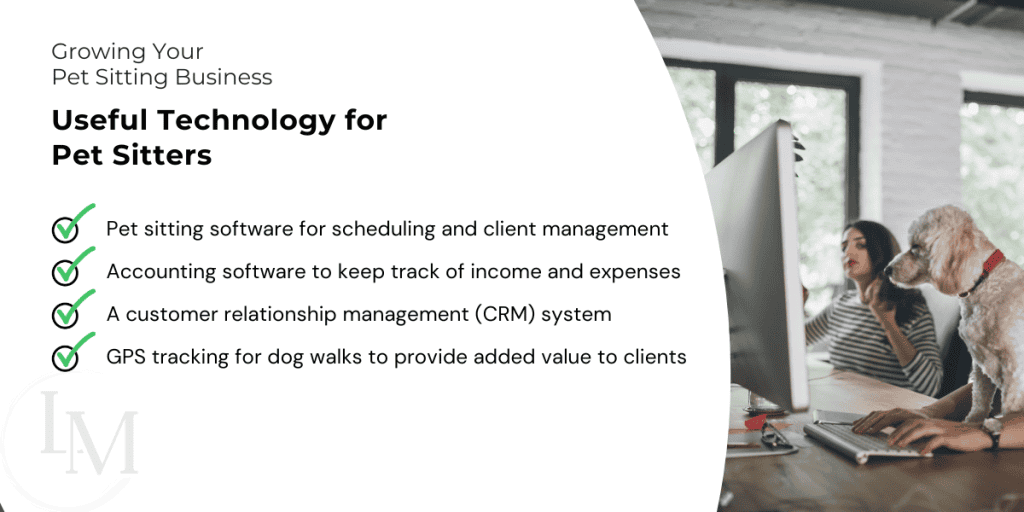
Helpful Technology for Pet Sitters
- Pet sitting software for scheduling and client management
- Accounting software to keep track of income and expenses
- A customer relationship management (CRM) system to manage client interactions
- GPS tracking apps for dog walks to provide added value to clients
The goal of technology is to make your life easier and improve your service. Choose tools that align with your specific needs and are user-friendly.
Conclusion: How To Start A Pet Sitting Business
You don’t have to implement every piece of advice in this post to become a successful pet sitter, but I’ve tried to give you everything you might want to consider.
After reading this post, you’ll know that becoming a successful pet sitter needs more than just a love of pets – you also need careful planning, dedication, and a commitment to providing top-notch care.
Here’s a quick reminder of the key steps we’ve covered:
- Planning Your Business: From defining your services to creating a solid business plan, laying the groundwork is crucial.
- Legal Requirements and Insurance: Ensuring you’re operating legally and have proper insurance protects you, your clients, and their beloved pets.
- Setting Up Operations: Efficient systems for scheduling, pet care protocols, and equipment management set the stage for smooth day-to-day operations.
- Pricing Your Services: Striking the right balance in your pricing ensures your business is both competitive and profitable.
- Marketing Your Business: A mix of digital marketing, networking, and word-of-mouth referrals helps you attract and retain clients.
- Providing Top-Notch Pet Care: At the heart of your business is the quality of care you provide. Exceptional service leads to happy pets and satisfied owners.
- Growing Your Business: As you establish yourself, opportunities for expansion through hiring, new services, or technology can take your business to the next level.
Unless you’re lucky, building a successful pet sitting business won’t happen overnight. It takes patience, persistence, and a willingness to learn and adapt.
There will be challenges along the way, from dealing with difficult pets to managing your time effectively. But with each challenge comes an opportunity to improve and grow.
An alternative to going it alone
If, after reading this, it feels a little daunting to set up a pet sitting business from scratch, think about using a pet sitting platform.
Apps like Rover and Pawshake take care of all the marketing, legal stuff, and scheduling so you can focus on doing what you set out to do – give your clients a loving home away from home for their pets!
If you’re interested in this route, check out this comparison between Rover and Pawshake – two of the biggest pet sitting platforms in the UK!






